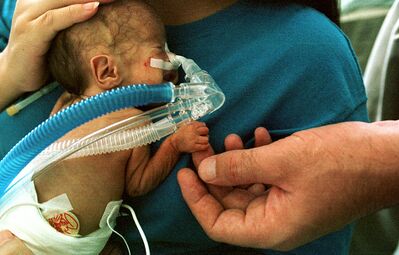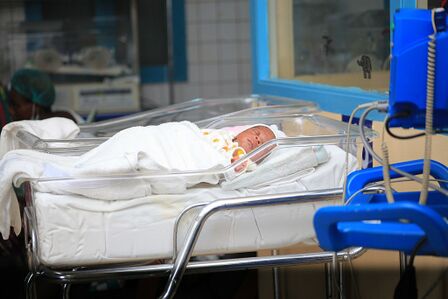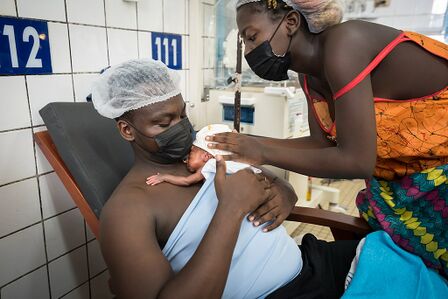Neonatal Intensive Care Unit (NICU)
Original Editor - Lucinda hampton
Top Contributors - Lucinda hampton, Stella Constantinides, Kim Jackson and Vidya Acharya
Introduction[edit | edit source]
Neonatal Intensive Care Units (NICUs) is for those infants who are preterm, have low birth weight, or perinatal problems, or congenital abnormalities, respiratory disorders, neuromuscular disorders and for those who have undergone thoraco-abdominal surgery[1]. A NICU has advanced life support equipment and a team of highly skilled specialist medical and nursing staff to meet the unique needs of newborn babies.[2]
Image 1: Premature infant CPAP
Neonatal staff: There are different types of staff in a NICU including:
- Neonatologists – doctors who specialise in looking after premature or ill newborns
- Nurses and midwives with special training in neonatal care
- Lactation consultants
- Allied healthcare providers such as social workers and physiotherapists
- Other medical specialists such as anaesthetists or surgeons[2].
The NICU can be overwhelming for parents as there are many pieces of equipment. The staff should explain to the parents what treatment, equipment and monitoring the baby needs eg. An incubator or heated cot to help regulate body temperature, a ventilator that assists breathing (in NICU), machines to deliver fluids/medicines via tubes directly into their veins, monitors attached to the baby’s body so that their heart rate, breathing rate and blood oxygen levels can be checked[2].
Parent's education and cooperation are very essential regarding the NICU physiotherapy and invasive procedures adopted in the NICU.[3]
Physiotherapy[edit | edit source]
The practice pattern of physiotherapists for neonates in neonatal intensive care units involves both chest physiotherapy as well neuromuscular physiotherapy[1].
Image 3: NICU a man performing the kangaroo method)
- Neuromuscular physiotherapy
- For neuromuscular dysfunction, common therapeutic strategies for neuromuscular physiotherapy include positioning, skin to skin holding (kangaroo care), therapeutic handling, orofacial stimulation, taping, range of motion exercise, soft tissue mobilization (surgical scar release), hydrotherapy and parent education (feeding, dressing, positioning of infants for sleep, interaction/play). These developmental strategies are beneficial for the promotion of posture and movement appropriate to gestational age and medical stability, to modulate sensory stimulation in the infant's NICU environment, to promote behavioral organization and physiological stability, to foster infant-parent attachment, and to provide direct intervention for neonatal feeding dysfunction and oral motor deficits.[1]
- Physiotherapists provide parent education on passive range of motion exercise, therapeutic handling, and positioning. A passive range of motion is mainly given to the infant who has congenital restriction of joint mobility.[1]
- Due to prolonged immobilization, lack of physical activity leads to demineralization and growth retardation of bone in newborns. Studies tell that the range of motion exercises performed by therapist in different joints helps in increasing bone mineral density and weight gain in premature newborns
2. Chest physiotherapy
- Chest physiotherapy techniques eg percussions, vibrations, positioning for postural drainage, and airway suctioning may be required eg 15 min, twice a day. At least 2—3 min be spent on each affected site while giving chest physical therapy for the airway clearance and to maintain the adequate levels of oxygenation[3]
In the NICU, neonates experience long-term sequel of pain during invasive medical procedures. Hydrotherapy helps in pain reduction and improvement in sleep cycle of hospitalized stable premature newborn. [3]
Sub Heading 3[edit | edit source]
Modern neonatal intensive care units symbolises sophistication, and high cost automatically follows. The projected requirements in terms of money, manpower and material involved put this treatment virtually out of reach for the developing countries. However, delivery of basic care, which is available to everyone in form of breastfeeding, thermoregulation by simple devices and prompt treatment of infections, can make a sea of a difference to the number of survivors.[4]
Resources[edit | edit source]
- bulleted list
- x
or
- numbered list
- x
References[edit | edit source]
- ↑ 1.0 1.1 1.2 1.3 Chokshi T, Alaparthi GK, Krishnan S, Vaishali K, Zulfeequer CP. Practice patterns of physiotherapists in neonatal intensive care units: A national survey. Indian journal of critical care medicine: peer-reviewed, official publication of Indian Society of Critical Care Medicine. 2013 Nov;17(6):359. Available:https://pubmed.ncbi.nlm.nih.gov/24501488/ (accessed 6.10.2021)
- ↑ 2.0 2.1 2.2 cahs health NICU Available:https://cahs.health.wa.gov.au/Our-services/Neonatology/Neonatal-Intensive-Care-Unit (accessed 6.10.2021)
- ↑ 3.0 3.1 3.2 Sharma N, Samuel AJ, Aranha VP. Pediatric physiotherapists' role in the neonatal intensive care unit: Parent and health-care providers' perspectives. Journal of Clinical Neonatology. 2018 Jul 1;7(3):111. Available: https://www.jcnonweb.com/article.asp?issn=2249-4847;year=2018;volume=7;issue=3;spage=111;epage=115;aulast=Sharma(accessed 6.10.2021)
- ↑ Daga SR, Daga AS. Neonatal intensive care in the developing countries: conservative or aggressive approach. InChild Health in the Tropics 1985 (pp. 233-245). Springer, Dordrecht.Available: https://link.springer.com/chapter/10.1007/978-94-009-5012-2_23 (accessed 7.10.2021)









